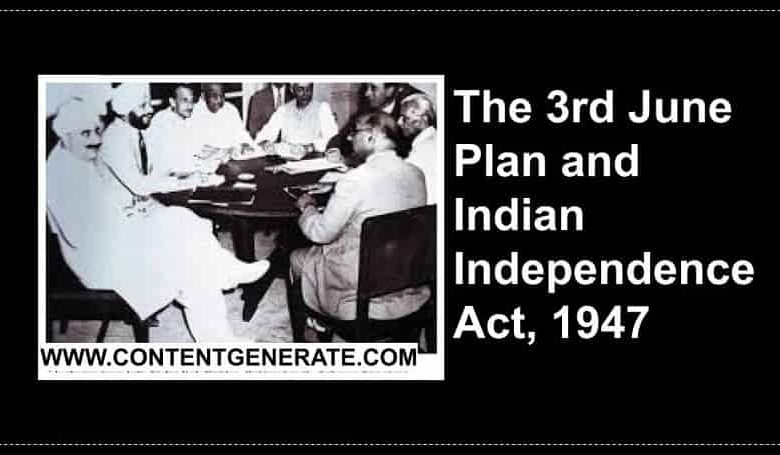Third June Plan and Indian Independence Act 1947

This post discusses the main features of the Third June Plan 1947 and the Indian Independence Act 1947.
Contents
Background
With the conclusion of WW II, the British wanted to leave India as soon as possible. They wanted to transfer powers to locals in a peaceful manner but the differences between two major political parties, the Muslim League and Congress, made it difficult.
British apparently attempted to create a compromise between both parties but in vain. After failing in their attempts to create a reconciliation with regard to a united India, the British announced a plan on 3rd June 1947 to partition India into two states. Today we know this announcement as the 3rd June Plan,1947.
What were the main features of the 3rd June Plan 1947?
1. Two States, India and Pakistan, would be created with the Dominion status on 15 August 1948.
2. The interim constitution of both states would be the 1935 Government of India Act.
3. Each state would have Dominion status and an Executive answerable to a Constituent Assembly.
4. Muslim majority provinces would be asked whether they wanted to stay in India or join Pakistan.
5. Princely states would have the right to either join India or Pakistan or remain independent.
The outcome of 3rd June Plan 1947
When on 3rd June 1947, the British announced its plan to partition India, the local political parties, the Congress, and the league welcomed it. This paved way for Indian independence and the establishment of two separate independent states in the Indian subcontinent.
To put the third June Plan into effect, the British parliament passed the Indian Independence Act on 15 July 1947. The Act stated on 15 August 1947, the Indian sub-continent would be partitioned into two dominion states – India and Pakistan. Each State would have complete freedom to pass any law it wished. The Government of India Act would be the provisional constitution until the new states framed their own.
On 14 August Pakistan came into being whereas India was declared on 15 August as an independent state.
Significance of 3rd June Plan
The third June plan, 1947 was an official and formal acceptance of the Partition of the Indian subcontinent into two independent states of Pakistan and India. The British and Congress had been trying to avoid the partition but now they had come to the realization that the only solution of the Indian subcontinent was partition.
The third June plan paved way for the passage of the Indian Independence Act, 1947 which finally led to the establishment of one of the largest Muslim nations on the map of the world.
Today, the announcement has a wide acceptance as a success of the vision and struggle of Mr. Jinnah and the league. Throughout the struggle, Quaid-e-Azam remained steadfast in his demand of Pakistan in the face of the last Indian viceroy Lord Mount Batten and Congress scramble to prevent the partition.
Describe the Independence Act 1947
In order to give effect to the Plan of June 3, the British Parliament on July 18, 1947, passed an Act known as the Indian Independence Act, 1947.
The main provisions of the act are as follows:
1. Indian subcontinent would be divided into two independent states of India and Pakistan on 15 August 1948. Both states would have dominion status.
2. Government of India Act 1935 would be the provisional constitution of both states until they make their own constitutions.
3. All treaties and agreements between the British and princely states would come to an end on 15 August 1947. The rulers of the princely states would have the right to join either Pakistan or India or remain independent.
4. People in Muslim majority provinces would be asked whether they wanted to join Pakistan or India.
5. The new Dominions would have the right to remain part of the British Commonwealth of Nations or choose to leave it.
6. The civil and army officers and servants would have the right to join either of the states as per their own wishes.
7. British would appoint Governor-General for Pakistan and India with full power provided in the Government of India Act 1935.
Regions that became part of Pakistan
Following were the areas that joined Pakistan either through voting in provincial assemblies,
Jirga and referendum.
1. West Punjab (Provincial Assembly unanimously decided to join Pakistan).
2. Sindh (Provincial Assembly unanimously decided to join Pakistan).
3. Balochistan (A Shahi Jirga in Balochistan decided to join Pakistan).
4. NWFP (people decided to join Pakistan in a referendum held in NWFP).
5. East Bengal (Provincial Assembly unanimously decided to join Pakistan)
6. District Sylhet (people decided to join Pakistan in a referendum).



